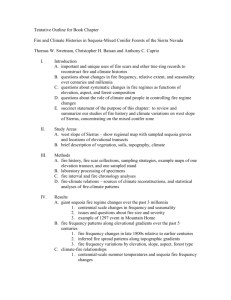CC-regime-complex-0
advertisement
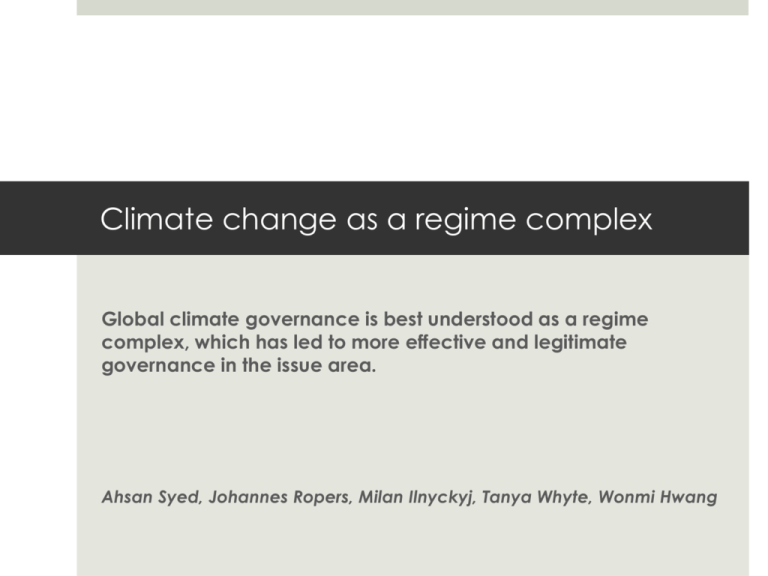
Climate change as a regime complex Global climate governance is best understood as a regime complex, which has led to more effective and legitimate governance in the issue area. Ahsan Syed, Johannes Ropers, Milan Ilnyckyj, Tanya Whyte, Wonmi Hwang Summary 1 - Defining a regime complex 2 - Climate as a regime complex 3 - Effectiveness 4 – Legitimacy 1 - Defining a regime complex “An array of partially overlapping and nonhierarchical institutions covering a particular issue area” -Raustiala and Victor (279) Raustiala and Victor make four observations about regime complexes: They “demonstrate path dependence,” (279) They promote “forum-shopping” by states looking to maximize their interests (280) There are legal inconstancies within complexes, which a variety of actors negotiate at different times and places rather than in one negotiation (280) States deal with inconsistencies through “implementation and interpretation” on a domestic level (280) 2 - Climate as a regime complex Overlapping and nonhierarchical institutions The United Nations Framework Convention on Climate Change (UNFCCC) The Kyoto Protocol European regional climate programs, including the Emission Trading System Emerging North American GHG trading systems: Regional Greenhouse Gas Initiative, Western Climate Initiative, etc Voluntary private sector initiatives Emission reduction efforts through multilateral bodies, including the UN, World Bank, etc Collaborative efforts between cities 2 - Climate as a regime complex Path dependence To a degree, the UNFCCC process is modeled on the approach used for ozone depletion: A framework convention (the 1985 Vienna Convention for ozone) Protocols to implement the objectives of the framework (1987 Montreal Protocol for ozone) The Kyoto Protocol was meant to achieve concrete gains toward UNFCCC objectives The climate process has been less effective – there are no simple substitutes to GHGs, and a far wider variety of activities produce them Still, the climate governance system demonstrates the path dependence that is characteristic of a regime complex 2 - Climate as a regime complex Promotion of forum shopping Different states have sought to address climate change through fora where they have influence and which they feel will produce outcomes consistent with their preferences The US Senate Byrd–Hagel Resolution blocked implementation of the Kyoto Protocol The US subsequently tried to address climate change through other fora, for instance by creating the Major Economies Forum in 2009 States have also engaged in regional efforts at cooperation 2 - Climate as a regime complex Legal inconsistencies, negotiations at many different times and places The UNFCCC process has already involved 19 Conferences of the Parties, held all over the world In addition, there have been countless other meetings among both governmental and non-governmental actors States have widely endorsed the objective of restraining warming to less than 2˚C above pre-industrial levels, but none have been willing to adopt and implement the emissions reductions necessary to meet that objective States have also failed to live up to their specific and voluntary Kyoto commitments, including Canada 3 - Effectiveness So far, at least, the climate change governance regime has not been effective In order to avoid dangerous climate change, the atmospheric concentration of greenhouse gases (GHGs) must be stabilized at a safe level Stabilizing the concentration of GHGs requires that net emissions fall to zero. What stabilization would look like: 3 - Effectiveness “Essentially, any specific concentration or radiativeforcing target requires emissions to fall to very low levels as the removal processes of the ocean and terrestrial systems saturate… [T]o reach a given stabilization target, emissions must ultimately be reduced well below current levels. For achievement of the stabilization categories I and II, negative net emissions are required towards the end of the century in many scenarios considered (high agreement, much evidence)” Climate Change 2007: Working Group III: Mitigation of Climate Change https://www.ipcc.ch/publications_and_data/ar4/wg3/en/tssts-ts-3-2-stabilization-scenarios.html What the world has been doing: Rising concentrations in parts per million (black line) Emissions in billions of tonnes per year (black line) Source: Climate Change 2007: Working Group I: The Physical Science Basis https://www.ipcc.ch/publications_and_data/ar4/wg1/en/ch2s2-3.html#2-3-1 Global Carbon Dioxide (CO2) emissions from fossil-fuels 1990-2008 Source: Boden, T.A., G. Marland, and R.J. Andres (2010). Global, Regional, and National Fossil-Fuel CO2 Emissions. Carbon Dioxide Information Analysis Center, Oak Ridge National Laboratory, U.S. Department of Energy, Oak Ridge, Tenn., U.S.A. doi 10.3334/CDIAC/00001_V2010. http://epa.gov/climatechange/ghgemissions/global.html Emissions in most regions are rising and expected to continue to rise Source: Climate Change 2007: Working Group III: Mitigation of Climate Change https://www.ipcc.ch/publications_and_data/ar4/wg3/en/figure-8-2.html Warming is being observed in all regions Source: Climate Change 2007: Working Group I: The Physical Science Basis https://www.ipcc.ch/publications_and_data/ar4/wg1/en/spmsspm-understanding-and.html 3 - Effectiveness The question is not whether climate change governance has been effective, but whether the emergence of climate change governance as a regime complex has been more effective than the alternatives To assess this question requires a counterfactual: what would have happened otherwise? A single unified regime? No action at all? Given the complexity of the issue and the range of emission sources, expecting a single regime to govern climate change is unrealistic 4 – Legitimacy Legitimacy can be considered in at least three ways Whether a governance system is perceived to be structured in a way that justly distributes costs and benefits between participants Whether the system grants participants a meaningful mechanism for expressing their views and preferences Whether the system is effective at serving its purpose The climate regime does best on the second criterion – inclusion. It does poorly in relation to effectiveness, and the fairness of the current approach is contested 4 – Legitimacy There can be conflicts between the different constituents of legitimacy A highly democratic process might end up deadlocked, reducing the effectiveness of the regime complex An approach that is perceived to constrain development opportunities may be rejected by one group of states, while an approach that requires no substantive action from large and fast-growing states may be questioned by others A regime complex that expresses the aspiration of all states for unending economic development will likely fail to effectively curb climate change Broad inclusion in climate fora can allow states determined to delay action to advance their aim Conclusions In many ways, the global climate governance regime represents the characteristics of a ‘regime complex’ While the regime complex has not been effective at adequately curbing emissions, it is not clear that there are alternative forms of governance that would work better By allowing states and other actors to engage with climate change through multiple existing fora, a degree of legitimacy has been conferred on global climate governance. In some cases, legitimacy and effectiveness have been at odds with one another


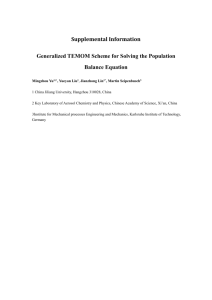
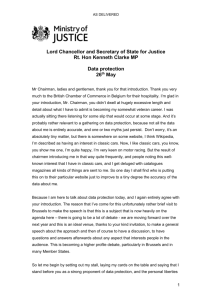
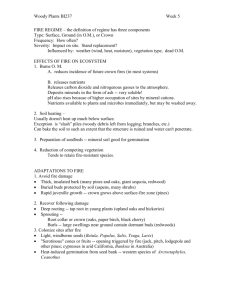
![Understanding barriers to transition in the MLP [PPT 1.19MB]](http://s2.studylib.net/store/data/005544558_1-6334f4f216c9ca191524b6f6ed43b6e2-300x300.png)

